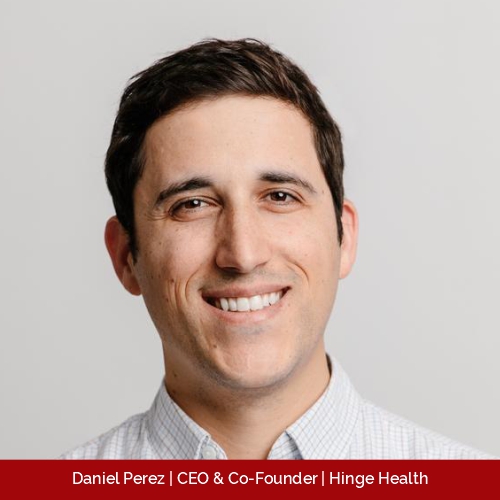Trending
April 10, 2025
February 15, 2025
February 2, 2025
The global health emergency of the pandemic has certainly clouded the importance of other health concerns. With the majority of the healthcare providers dealing with the consequences of the pandemic, other medical problems are under dim light. But pandemics cannot be an excuse to wave off from the responsibilities which is why there are numerous specialties integrating telehealth and helping the unaided complications. In the forefront is Hinge Health, a digital platform that currently tailors each user to job-specific prevention measures with the option of personal virtual sessions with physical therapists, as well as advice for pre-and post-rehabilitation following surgery.
Hinge Health is pioneering the world’s most patient-centered Digital Clinic for back and joint pain. Being ranked as the #1 musculoskeletal (MSK) solution for employers and health plans. MSK conditions have been a major contributor to the medical spending for US employers. The reason is poor access to professional advice or ignoring the issues. However, Hinge Health is making it easier to bring expert-recommended care to millions of patients by being the first company to combine wearable-sensor guided exercise therapy with one-on-one PT health coaching, and patient education. Furthermore, it has clinically validated results across 4 peer-reviewed studies showcasing reductions in chronic pain, opioid use, anxiety, depression, absenteeism, and costly surgeries.

Hinge Health currently works with Fortune 500 companies and 300+ health plan, employer, and public sector customers. Hinge Health has raised $426M to date and has 600+ employees across our San Francisco, Portland, Minneapolis, Chicago, and remote offices. Most recently, it has expanded the version of Digital Musculoskeletal Clinic (MSK) available, adding clinical and technical capabilities to cover the full continuum of care.
In a recent press release, Hinge Health announced that it has secured $300M in series D round to expand the clinical capabilities as an end-to-end Digital MSK Clinic for all back and joint pain care. The fundraising was heavily oversubscribed and jointly led by Coatue Management and Tiger Global with participation from existing investors Atomico, Insight Partners, Quadrille, 11.2 Capital, Lead Edge Capital, Bessemer Venture Partners, and Heuristic Capital. This has made Hinge Health one of the highest-valued privately held digital health companies in the United States.
The acceleration of digital health solutions is not uncanny considering the ongoing crisis of COVID-19. In 2020, the customer base of Hinge Health has tripled in numbers and the revenue has quadrupled while maintaining 100% client retention. Besides, Q4 alone witnessed a 937% growth in the added covered lives. The leading healthcare provider is a market leader and was chosen by 4 in 5 employees with a highly effective digital MSK solution. Hinge Health is the only digital MSK Clinic that has gone beyond digital physical therapy and to deliver the industry’s most complete clinical care model, surrounding members with access to physical therapists, physicians, health coaches, and technology such as wearable sensors to guide exercise therapy. The programs at Hinge Health are specifically curated for every population’s needs from prevention to post-surgery.
“Hinge Health is eliminating variability in healthcare quality and instead of delivering better outcomes through consistent digital-first clinical care no matter where a person lives across the country,” explained CEO and Co-Founder Daniel Perez. “We are investing in deepening our MSK clinical capabilities by building advanced technologies and tripling our clinical team of doctors, physical therapists, and health coaches.”
Hinge Health is introducing a new digital platform which will be a virtual digital musculoskeletal clinic—distinguishing it from the prior programs as most of the programs are focused on MSK chronic conditions. “That by definition is conditions that have existed for 12 weeks or more and that is a reasonable place to start with covering MSK because roughly three-quarters of the costs come from those chronic conditions,” quotes Daniel.
The team at Hinge Health is also looking to address other important areas along the MSK continuum of care. This can be achieved through the digital clinic. The focus will be on helping prevent the problems before they arise and then acute conditions, conditions that are needed to be treated in a period of days to maybe a few months. Alongside, Hinge will also have a chronic program which is the flagship program and is focused on behavioral to try and encourage healthy habit formation. The goal is to drive down these elective, but very expensive surgeries that often are not really effective for chronic pain.
In addition to this, the continuum would be the perisurgical care that would be both what is now called prehab or pre-rehabilitation. The aim is to make somebody as strong and flexible as possible before the surgery and post-operative rehabilitation. Physical therapy, exercises and movements, and mobilizations require following the surgery in order to maximize outcomes for the best recovery. There is also an inclusion of expert medical opinion service and that is for those who are seriously considering surgery. Daniel adds, “We are providing a service led by specialists who review the patient’s notes and imaging and then can provide a recommendation on what they believe the appropriate next step is.”
The adoption of telemedicine has comparatively increased amid the crisis but the trend had started before the pandemic. People realized that digital solutions benefitted for a variety of reasons first being the convenience and second being a tap away. Remote delivery of care was already rising and in COVID-19 it overpowered the traditional clinical setting. Telehealth erases geographical limits making healthcare more accessible—especially for the rural population who are deprived of the benefits that the urban areas have ready access to. It becomes a real equalizer for healthcare benefits.
Daniel concludes, “We’ve seen a lot of demand during COVID and we’ve had to it as part of our calculations and dramatically expanding our capabilities and our staffing, physical therapists and we’re now hiring more physicians as well, to accommodate this increased demand for remote care.”